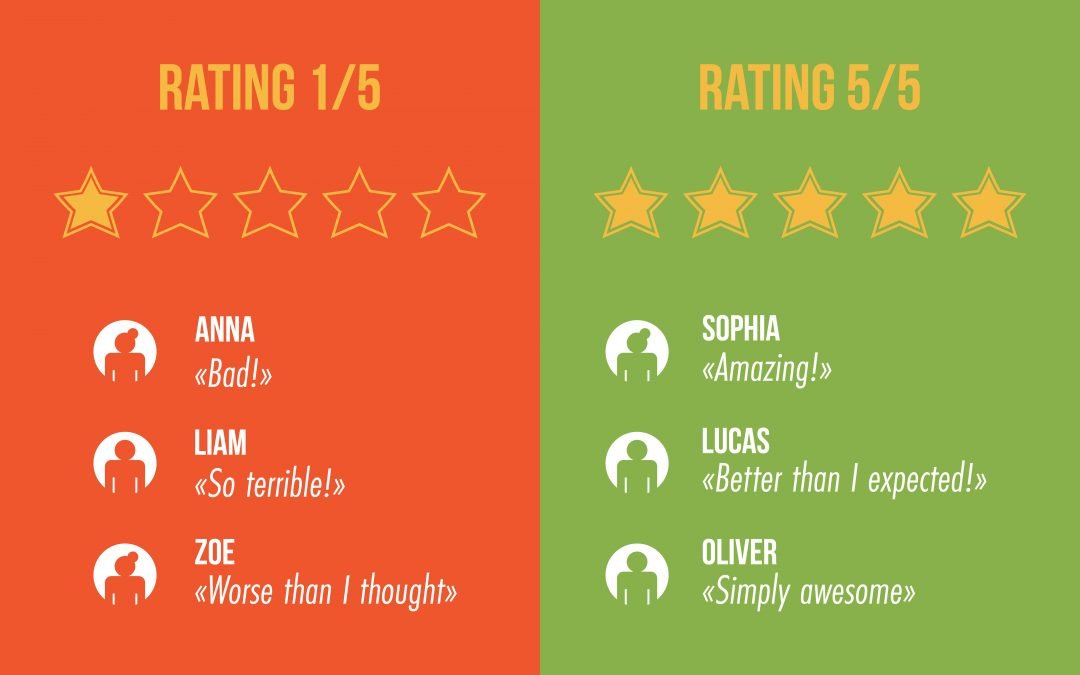Online transactions have gotten so easy and convenient that Americans are starting to do it “as often as taking out the trash”. The Washington Post reported that about a third of adults buy something on their phone or computer at least once per week. Marketing data has identified online reviews to be a huge influence on the buying behavior of consumers. A 2016 survey by the Pew Research Center found that 82% of American adult shoppers “sometimes or always” read reviews when making new purchases. More than two-thirds of regular readers believe that the testimonials are “generally accurate.”
Unfortunately, consumers are more drawn to negative reviews according to several studies. The 2018 Local Consumer Review Survey identified negative reviews to stop 40% of buyers from wanting to use a business. Dissatisfied customers typically tell 9 to 15 other people about their bad experience and some tell 20 or more. But research on the biases and demographics of online reviewers suggests that our faith in negative reviews might be misguided. For instance, I recently looked for vacation packages online and noticed that customer reviews about the destinations and tour guides were overflowing with positive praises.
The few people who shared their negative experiences didn’t seem like the travel company’s fault – they couldn’t enjoy the tour because they got food poisoning, they missed a day of the tour because their flight got cancelled, or they couldn’t get a refund for the trip because they don’t have travel insurance. Consumers have a tendency to negatively review products for issues that are outside of a company’s control. Just like giving a one-star for books they haven’t read just because the package got destroyed in transit. You can read a lot of these on Amazon.
Here’s another example of how you can’t please everyone. The Great Wall of China has more than 12,000 Google reviews but only averaged at 4.2 stars. And you’d think one of the greatest wonders of the world would get a perfect score. One reviewer who gave a one-star rating wrote “Bit of a long walk and I nearly got pushed off by the crowd. Not happy Jan.” Another one wrote, “My kid was hungry and I spent the whole day looking for a hot dog cart not to find one what the heck add some food carts.”
Why Consumers Care So Much About Negative Reviews
Positive comments are more common than negative reviews, studies show. This creates a scarcity of negative ratings that consumers associate with value. A 2014 study led by MIT marketing professor Duncan Simester analyzed a data sample from Amazon. It was found that 59 percent of reviews with a verified purchase had five stars and only 4.8 percent were rated one star.
Dr. Simester explained, “The infrequent nature of negative reviews may help to distinguish them from other reviews,” Thus, consumers consequently pay more attention to them. He also pointed out that people consider negative reviews as windows into what could go wrong. A bride might think “Is this place worth visiting for our honeymoon?” Or, an adventurer might think “Will this activity give me the thrill I’m expecting?”. Consumers may see negative reviews as more informative because they share the deficiencies of a product or service, even if they’re not that accurate.
According to another study, people use negative reviews to understand the risk and reduce the losses. Consumers want to feel secure in their decision-making processes. It was also observed that after reports about fake five-star reviews surfaced, people relied more on negative reviews because they seem more trustworthy.
Online reviews are becoming less trustworthy
The credibility of all online reviews is questionable. A 2016 study found very little correlation between objective ratings produced by Consumer Reports and online consumer ratings. The reviews are subjective and people who write them aren’t average. Online reviewers “are more likely to buy things in unusual sizes, make returns, be married, have more children, be younger and less wealthy, and have graduate degrees than the average consumer,” according to a 2014 study. Dr. Simester adds, “Only 1.5 percent of people leave reviews or 15 people out of 1,000.”
It was noted that reviews are often circumstantial. For instance, when it comes to travel reviews, companionship could affect how customers rate the trip. The Electronic Commerce Research and Applications study analyzed 125,076 online reviews and observed that people traveling with significant others wrote the most positive reviews. Those traveling with friends also shared good experiences. The most negative reviews came from people traveling alone or for business. Thus, it was concluded that experiences change depending on who we’re with, expectations, and travel expertise.
A forthcoming study from Ulrike Gretzel, director of research at Netnografica and communications professor at the University of Southern California, suggests that an individual’s motivations can also taint their neutrality. This can be observed on the reviews in TripAdvisor, an American travel and restaurant website. The site’s “Super Contributors” write more negative reviews than less active members. Gretzel explains that these people tend to write “more critically to appear more professional” since they have formed identities around being expert travel reviewers.
It’s time for consumers to take negative reviews with a heaping spoonful or two of salt because a lot of factors are involved, including emotions. Another to be wary, according to Dr. Simesterone, is roughly one in 15 people write reviews about a product they haven’t actually used. He calls them “self-appointed brand managers.” These individuals write unsolicited, speculative negative reviews. The problem is, most consumers are bad at distinguishing authentic reviews and end up being fooled.
The right way to read online reviews
Still, online reviews can be pretty useful whether you’re planning on buying a laptop or hiring a contractor. They can be a great way of verifying the quality of a product or service (some sites are better than others). It’s important to think critically when reading reviews. Do not let your excitement compromise your ability to make a good decision. Eric K. Clemons, Professor at the University of Pennsylvania’s Wharton School, shares that people are more likely to write reviews in the moment of extreme emotion. This is why you see numerous rave reviews and a number of spiteful ones.
When you’re reading reviews, skip the most polarized perspectives. Find ones that are closer to the median like three-star reviews. They tend to be more honest, moderate and detailed. Then, ask yourself, “Does this review mention the issues I care about?” Let’s say you’re going on a ski trip. You’re hesitant to book with a certain tour company even if it has a high rating because of the presence of a bad review. But you have to ask, “Is this reviewer like me? Do we have the same expectations?” If not, you can disregard it.
Finally, pay attention to the details of the review rather than the general impressions and rating. Dr. Gretzel adds that the number of stars often has “very little to do with” their written explanation. If you’re still not sure about the credibility, you can check the reviewer’s profile. A paid reviewer will not have a lot of written reviews under his name. If he has fewer than 10, it’s probably fake. Focus on the most thorough reviews and those that will help you make a decision.




